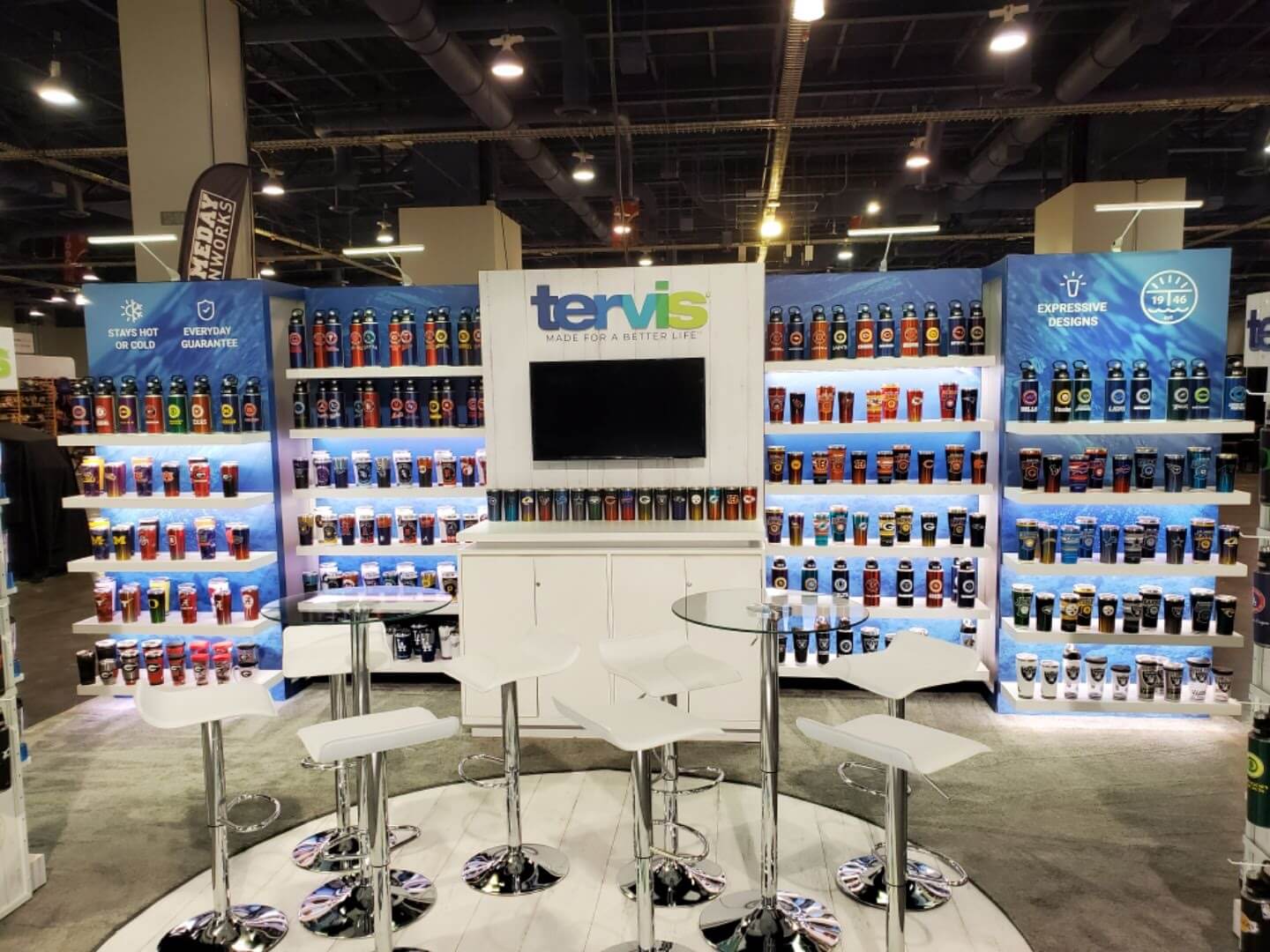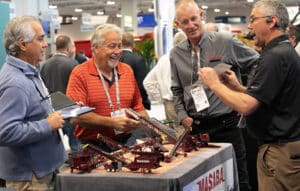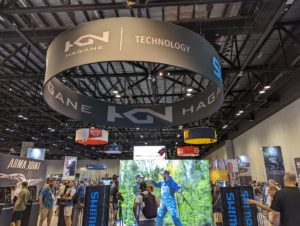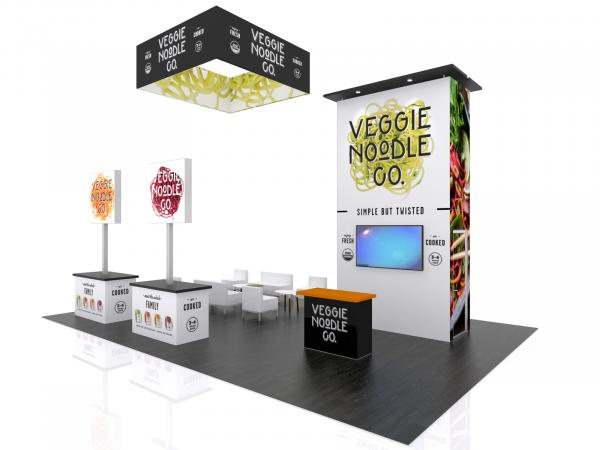Trade shows are bustling hubs where businesses come to show off their best products and services. They’re the places where first impressions count a lot. If you’ve ever been to one, you know that a well-displayed product can draw a crowd, while a poorly displayed one might get overlooked. But how do you make sure your trade show products stand out? Whether you’re aiming for more sales, leads, or just want to boost your brand, there’s an art to showcasing products effectively.
In this article, we’ll explore the essentials—from understanding your audience and setting clear goals, to the design intricacies like lighting, interactive displays, and signage. We’ll also delve into the importance of choosing a prime location, integrating technology, and keeping your display fresh throughout the event. With the right approach, you can transform your trade show booth into an attendee magnet. So, let’s dive in and make sure your products get the attention they deserve.
How to Display Products at a Trade Show: Aligning Your Exhibit with Your Goals
At the heart of every successful trade show display lies a clear objective. Before diving into design decisions or flashy setups, you must first define what you hope to achieve. Whether it’s generating sales, collecting leads, or amplifying your brand’s presence, setting clear goals will pave the way for meaningful decisions in every other aspect of your display.
Determining What You Want to Achieve: Sales, Leads, Brand Exposure, etc.
Before the glitz and glamour of product displays come into play, take a step back and evaluate the primary purpose of your participation. Are you there to introduce a new product, hoping for immediate sales? Perhaps you’re more interested in meeting potential clients and partners, focusing on leads. Or maybe, your mission is to increase brand awareness, ensuring that attendees remember your name long after the show concludes. Each objective demands a distinct approach, so clarity at this juncture is paramount.
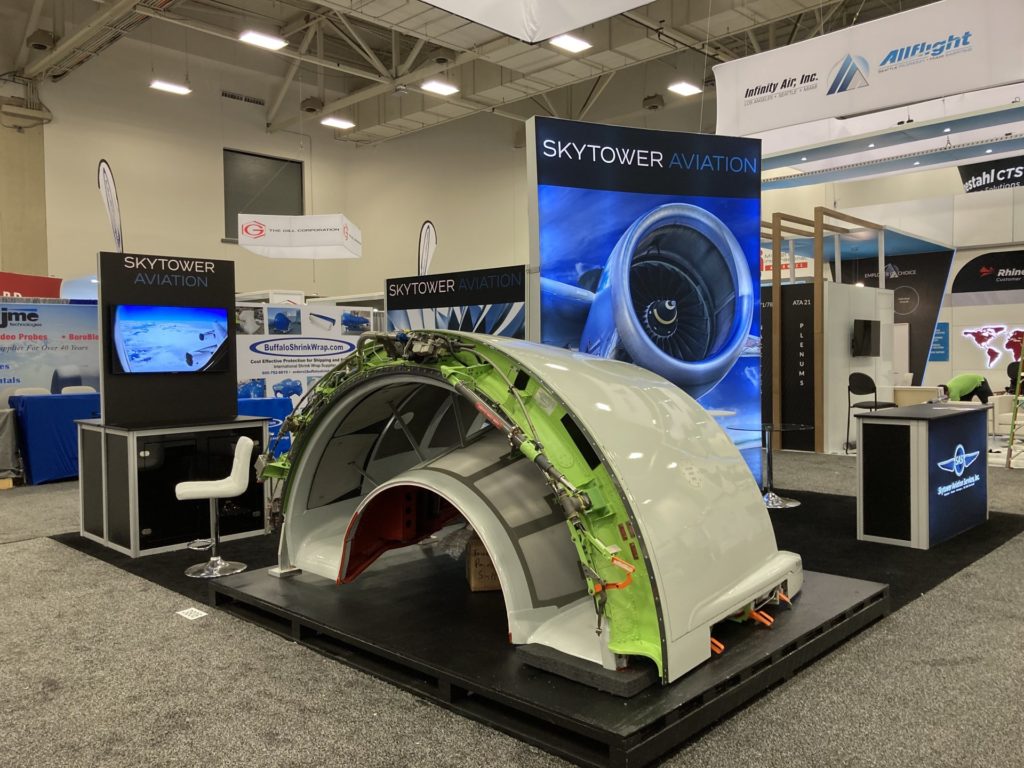
How These Goals Influence Your Display Choices
With a clear target in sight, your subsequent choices become more streamlined. For instance, if direct sales are your priority, you’d want an inviting space that allows for product demonstrations and immediate transactions. Should lead generation be the aim, interactive setups that encourage visitors to leave their contact details, such as sign-up sheets or digital kiosks, become critical. And for brand exposure, a visually captivating booth that resonates with your brand’s identity and values will create lasting impressions. Each goal you set dictates a tailored path in designing your booth and choosing display elements.
How to Display Products at a Trade Show? Know Your Audience
In the vast world of trade shows, a one-size-fits-all approach rarely succeeds. Knowing and understanding your audience is pivotal. By aligning your display to cater to the specific interests and preferences of your target demographic, you not only capture their attention but also foster meaningful interactions that can lead to business opportunities.
Researching Your Target Demographic
Dive deep into understanding who your ideal attendees are. Are they industry professionals, potential partners, or end consumers? What age group do they belong to, and what are their primary interests? Consider conducting pre-show surveys, studying past trade show data, or even analyzing your product’s existing customer demographics. Armed with this knowledge, you can craft a more targeted and effective strategy for your display.
Tailoring Your Display to Appeal to Their Preferences and Needs
Once you’ve gathered insights about your target audience, it’s time to put that knowledge into action. For a younger tech-savvy crowd, integrating cutting-edge technology and interactive elements might be a hit. Meanwhile, for industry professionals, providing in-depth product specifications and data could be the key. If you’re targeting end consumers, hands-on product demonstrations and free samples might be enticing. Remember, the more aligned your booth is with your audience’s preferences, the higher the chances of them stopping by and engaging with you.

How to Display Products at a Trade Show for Maximum Exposure
The real estate mantra, “location, location, location,” isn’t just relevant to property – it’s essential for trade shows as well. Your booth’s location can significantly influence the foot traffic you receive and, consequently, your event’s success. Strategically positioning your booth can be the difference between being the center of attention or being overlooked.
Importance of Booth Placement
At a trade show, your booth’s placement can determine your visibility and accessibility. Prime spots are typically near the entrance, food and drink areas, or alongside main pathways, as these see the highest footfall. A tucked-away booth might miss potential visitors simply because they didn’t walk that route. It’s essential to recognize that a well-placed booth amplifies your chances of meeting prospective clients, making sales, and increasing brand exposure.
Read our guide how to attract people to your booth.
Tips for Securing Prime Locations at Trade Shows
Book Early: The best spots often get snapped up quickly. Ensure you’re among the first to book to have a broader choice of locations.
- Build Relationships with Organizers: Returning exhibitors with good relationships often get preferential treatment. Attend organizer meetups, provide feedback, and maintain friendly interactions.
- Understand the Floor Plan: Familiarize yourself with the layout, noting entrances, exits, main aisles, and key attraction points. This will give you a clearer idea of which spots will guarantee more visibility.
- Budget Appropriately: Prime locations might come at a premium. Ensure your budget accounts for this, recognizing the potential return on investment a better spot can provide.
- Consider Traffic Flow: Even within prime areas, think about how attendees will move. Opt for spots that naturally guide the crowd toward your booth, rather than places they might bypass.
By strategically selecting your booth’s location and leveraging these tips, you can set the stage for a successful trade show experience.
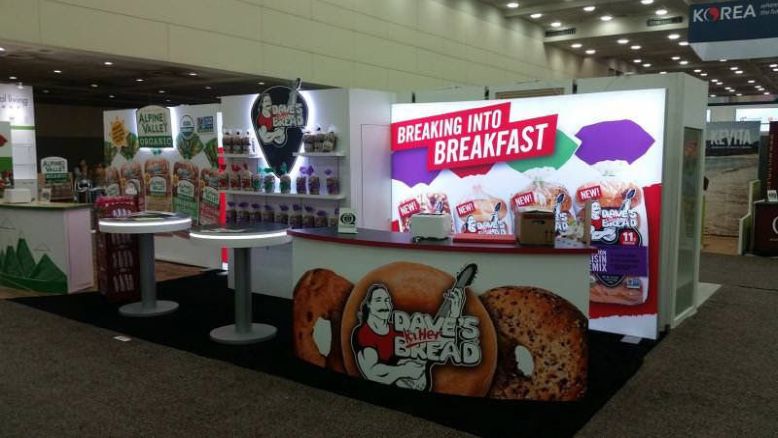
Mastering Display Design Basics: How to Display Your Products Effectively at a Trade Show
A well-designed booth can be the cornerstone of your trade show success. It not only captivates attention but also communicates the essence of your brand and products. But how do you strike a balance between being visually appealing and informative? Let’s explore the foundational elements of an effective trade show booth design.
Keeping it Clean and Uncluttered
Simplicity is key. Overloading your booth with too much information or products can be overwhelming for attendees. A cluttered space can deter visitors or make them feel confined, leading to shorter interactions.
- Minimalist Approach: Prioritize the most essential products or information. Less can often be more when it ensures clarity.
- Clear Pathways: Ensure that there’s a clear pathway for attendees to walk through or approach your booth, facilitating smoother interactions.
- Organized Literature: If providing flyers or brochures, have organized stands or holders rather than spreading them out haphazardly.
Read more about how to make your trade show booth stand out.
Use of Colors, Lighting, and Branding
Visual appeal can draw attendees from across the hall. The right mix of colors, lighting, and brand representation can set the mood and convey your brand’s personality.
- Brand Consistency: Ensure your booth reflects your brand’s colors, logos, and style, reinforcing brand recognition.
- Strategic Lighting: Highlight key products or areas using spotlights, or use ambient lighting to set a specific mood or atmosphere.
- Color Psychology: Different colors evoke different emotions. Choose colors that resonate with your brand’s message and the reaction you want from attendees.
Ensuring All Displays are Easily Visible and Accessible
Attendees should be able to view and interact with your products effortlessly. If they can’t reach or clearly see something, they might move on without engaging.
- Elevated Displays: Raise essential products or displays to eye level to ensure maximum visibility.
- Open Layout: Ensure that attendees can easily reach products for hands-on interaction, without barriers or obstructions.
- Signage: Use clear and legible signs to guide attendees or provide information. These should be high enough to be seen from a distance.
By adhering to these design basics, your booth can be both aesthetically pleasing and functionally effective, ensuring a memorable experience for all attendees.
Read our guide how to build a trade show booth.
Maximizing Engagement with Interactive Displays: How to Display Your Products at a Trade Show
In the digital age, mere visual appeal isn’t enough. Attendees crave engagement – they want to touch, feel, and immerse themselves in experiences. Interactive displays serve as a bridge, allowing a tangible connection between your brand and your audience, making your booth unforgettable.

Benefits of Making Your Display Interactive
Increased Engagement: When attendees can interact with a display, they’re more likely to spend more time at your booth, exploring what you have to offer.
- Memorable Experiences: Interactive experiences, by their very nature, are more memorable than passive viewing. This ensures your brand stays top of mind even after the event.
- Direct Feedback: Interactive displays can provide immediate feedback on product interest or attendee preferences, helping you adjust your approach in real-time.
- Higher Retention: When information or product features are presented interactively, attendees are more likely to retain and recall that information later.
Ideas: Touch Screens, Product Demos, VR Experiences
- Touch Screens: Use touch screens to showcase product catalogs, gather attendee details, or even conduct quick surveys. They offer a dynamic way to present information, allowing attendees to explore at their own pace.
- Product Demos: Live demonstrations of how a product works can captivate an audience. Whether it’s a gadget, software, or a physical product, seeing it in action can clarify its benefits and appeal.
- VR Experiences: Virtual reality (VR) can transport attendees to different worlds, whether it’s a virtual tour of a property for real estate companies or an immersive game for tech brands. It’s novel, exciting, and leaves a lasting impression.
Incorporating interactive elements in your display not only enriches the attendee experience but also amplifies the impact of your brand’s message.
Enhancing Visibility with High-Quality Signage: Key Strategies for Displaying Products at Trade Shows
In the hustle and bustle of a trade show, amidst a sea of booths and displays, high-quality signage can be your beacon. It not only guides attendees to your booth but also conveys your brand’s professionalism and attention to detail. A sign can speak volumes, and ensuring its quality can significantly influence first impressions.
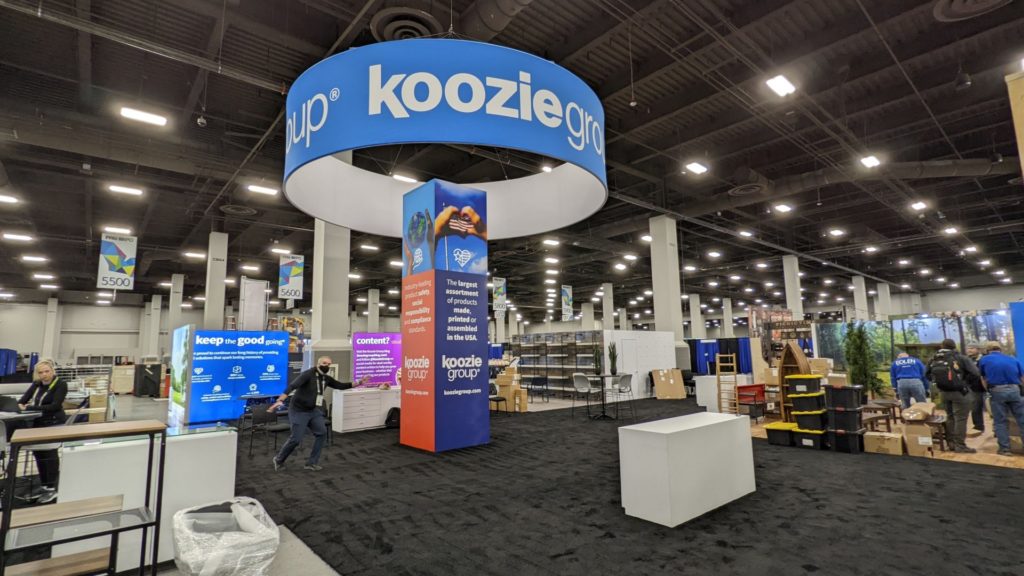
Importance of Clear, Readable Signs
Guiding Light: A clear sign acts as a beacon, guiding potential clients or partners to your booth amidst the crowd.
Brand Image: High-quality, professional trade show hanging signs reflect a brand that values quality and detail, fostering trust in potential clients or partners.
Concise Information Delivery: Attendees can quickly gauge what you offer, your brand’s ethos, or any other critical information you wish to convey, even from a distance.
Tips for Creating Effective Signage: Font Choice, Size, Contrast
- Font Choice: Opt for clear, readable fonts. Avoid overly decorative fonts which can be challenging to read, especially from a distance.
- Size Matters: Ensure your font size is large enough to be legible from afar. This ensures that attendees can spot and understand your sign even from the other side of the hall.
- Contrast is Key: Use colors that stand out against their background. High contrast ensures that your sign captures attention and remains readable in various lighting conditions. For example, dark text on a light background or vice versa can be more effective than shades that are too similar.
- Material and Finish: Opt for durable materials and finishes that reflect light appropriately. A glossy finish might cause glare, making the sign hard to read, whereas a matte finish can be more visually accessible.
By investing in high-quality signage, you not only guide attendees effectively but also showcase your brand’s commitment to excellence.
The Art of Illuminating Your Products at Trade Shows
Lighting can be a game-changer in a trade show setting. Beyond mere visibility, the right lighting can set the mood, accentuate products, and craft an unforgettable experience for attendees. Just as a theater uses lighting to spotlight a performer or set a scene’s mood, a trade booth can use lighting to draw attention and create a desired atmosphere.
Different Lighting Options and Their Effects
Ambient Lighting: This is the primary light source, providing general illumination for the booth. Soft, even ambient lighting ensures there are no dark spots and creates a welcoming environment.
Spotlights: These are used to highlight specific products or areas within the booth. If there’s a new product or a central feature, a spotlight can direct attendees’ attention right to it.
Accent Lighting: Accent lights provide depth and dimension to displays. They can be used to backlight signs, illuminate product shelves, or provide depth to graphic displays.
Task Lighting: In areas where specific activities occur, like product demos or writing stations, task lighting ensures adequate illumination for detailed work.
Colored Lighting: Using lights of specific colors can set the mood or resonate with brand colors. For instance, a tech company launching an eco-friendly product might use green lighting to emphasize the environmental theme.
How Lighting Can Highlight Products and Create Ambiance
Product Emphasis: Proper lighting can make products pop, drawing attention and enticing attendees to come closer. For example, a jewelry company might use spotlights to make gemstones sparkle, while a tech company might use cool white lights to make gadgets look sleek.
Mood Setting: The color and intensity of lights can influence attendees’ emotions. Warm lighting might create a cozy, welcoming feel, while cooler lighting could present a modern, cutting-edge atmosphere.
Enhanced Signage Visibility: Lighting can ensure signs are easily readable, guiding attendees effortlessly through your booth’s offerings.
Interactive Play: Lighting can be synchronized with music or interactive displays, creating a multisensory experience for attendees.
Mastering the art of proper lighting can transform a booth from ordinary to extraordinary, creating a visually appealing and emotionally resonant environment for attendees.
Read more about trade show lighting.
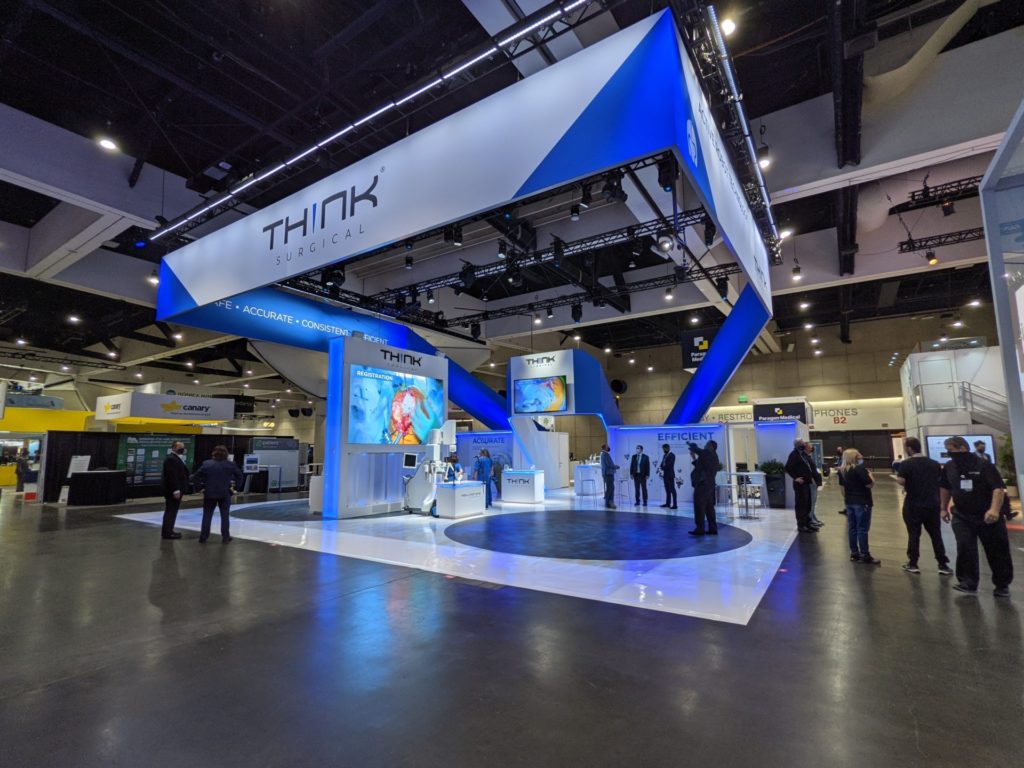
Creative Takeaways for Displaying Products at Trade Shows
Trade shows can be overwhelming experiences for attendees, with a plethora of booths vying for their attention. Amidst this whirlwind of activity, it becomes crucial for exhibitors to offer something tangible that attendees can take with them. This tangible element not only serves as a reminder of the brand but also as a gateway for future interactions.
Importance of Having Something Attendees Can Leave With: Brochures, Samples, etc.
Handing out items like brochures, samples, or even business cards ensures your brand remains in the attendee’s consciousness long after the event ends. For instance, a well-crafted brochure can offer deeper insights into your products, services, or brand story. On the other hand, samples allow attendees to experience the product firsthand, potentially leading to future purchases. Such takeaways become especially vital in cases where attendees might be interested but are in a hurry. They can revisit the information at their leisure, thereby extending the duration of your brand’s impact.
Read more about how to prepare for a trade show.
Making Sure Takeaways are Memorable and Useful
The key to an effective takeaway lies in its utility and memorability. It shouldn’t just be a piece of paper or a product. It should resonate with the brand’s essence and offer value to the recipient. For instance, if you’re in the tech industry, perhaps a branded USB drive loaded with product information could be a useful and relevant giveaway. Alternatively, for a beauty brand, sample-sized versions of a popular product might be the perfect choice. The idea is to ensure that the takeaway not only reminds attendees of your brand but also provides them with a genuine benefit, enhancing the chances of future engagement.
By integrating valuable and memorable takeaways into your trade show strategy, you effectively extend the conversation with attendees beyond the confines of the event, paving the way for sustained brand interactions.
Read more about trade show giveaway ideas.
How to Display Products at a Trade Show? Staffing Your Booth
One of the most crucial elements of a successful trade show booth isn’t just the design, products, or displays—it’s the people. Your staff serve as the face of your brand during the event, making their preparation and demeanor vital to creating positive impressions and meaningful connections.
Training Staff on Product Knowledge and Customer Engagement
Before the show begins, every member of your booth’s team should undergo thorough training. This training should encompass deep dives into the products or services you’re showcasing, ensuring that they can confidently answer questions and address concerns. But product knowledge is just one part of the equation. It’s equally essential to train staff on engaging with attendees effectively. This might involve role-playing exercises to simulate potential interactions or providing guidelines on how to handle challenging questions or situations. The goal is to equip your team with both the information and the interpersonal skills they need to represent your brand positively and productively.
Importance of Approachable and Informed Representatives
At a trade show, attendees might interact with dozens, if not hundreds, of booths. What sets one apart from another often isn’t just the product but the human interaction. Approachable, friendly, and knowledgeable representatives can make attendees feel valued, heard, and interested.
An informed representative can provide instant answers, reducing potential friction points for attendees. On the flip side, an approachable demeanor invites conversation, questions, and deeper engagement. When attendees feel that they’re speaking with someone genuinely interested in addressing their needs and concerns, they’re more likely to form a positive association with the brand.
In essence, while the design and setup of your booth are vital, it’s the human touch—the smiles, the conversations, and the connections—that often leaves the most lasting impression. By ensuring your booth is staffed with well-trained, approachable, and knowledgeable representatives, you maximize the potential for successful and impactful interactions.
Read more about what to wear to a trade show.
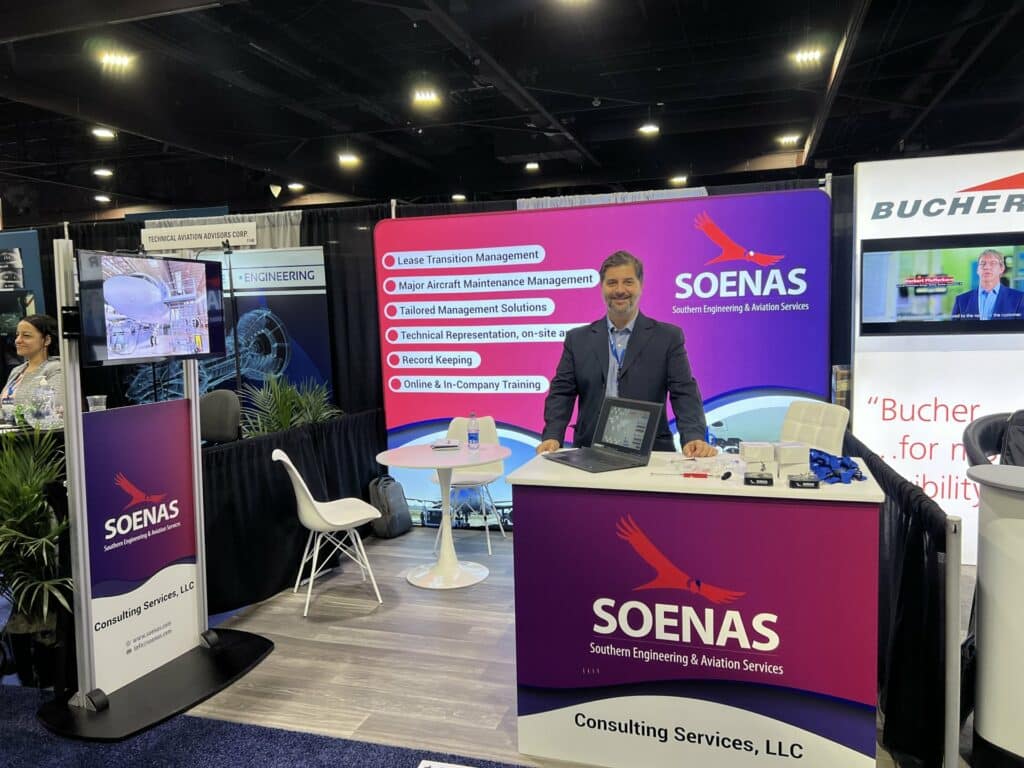
Innovative Use of Technology to Display Products at Trade Shows
In today’s digital age, integrating technology into your trade show booth can be a game-changer. Beyond merely showcasing your brand’s modernity, the right tech solutions can enhance the attendee experience, streamline interactions, and even provide invaluable data for future engagements.
Ways to Integrate Technology: QR Codes, Digital Catalogs, Interactive Screens
Integrating technology into your booth doesn’t necessarily mean a complete overhaul. Sometimes, the simplest solutions can be the most effective.
QR Codes, for instance, are easy to set up and can be scanned by most smartphones. By scanning a QR code, attendees can be directed to your website, sign up for newsletters, or even download digital brochures.
Digital Catalogs present an eco-friendly and dynamic alternative to traditional paper brochures. They allow attendees to browse through your product range on tablets or touch screens at the booth. Plus, they can be easily updated to reflect any changes, ensuring that the information presented is always current.
Interactive Screens can provide a more immersive experience. Attendees can interact with your products or services in real-time, watch product demos, or even play branded games. These screens not only engage but also inform, often in more memorable ways than traditional methods.
How Tech Can Enhance the Attendee Experience and Capture Leads
The right technology can elevate an attendee’s experience from passive viewing to active engagement. Interactive platforms, for instance, can make learning about your product or service fun and memorable. But beyond the immediate experience, technology can also provide tools for future engagement.
For instance, digital sign-up sheets can help you capture attendee details seamlessly, facilitating follow-ups post-event. Similarly, analytics from interactive platforms can offer insights into what products or features caught the most attention, helping refine future presentations or marketing strategies.
Furthermore, technology can also streamline the attendee experience. QR codes can provide quick access to product details, eliminating the need for attendees to wait for a representative to become available. Digital catalogs can be emailed directly to attendees, ensuring they have a copy even if they run out of hands to carry physical brochures.
In summary, the thoughtful integration of technology can do more than just dazzle; it can provide tools and insights that enhance both the attendee experience and your brand’s potential for meaningful connections.
Read more about are trade shows worth it.
How to Display Products at a Trade Show? Conclusion
Trade shows are much more than just setting up a booth and displaying products. They’re an opportunity, a stage where your brand can shine, connect, and leave a lasting mark on potential clients or partners. From the very beginning, when you define your goals, to the very end, where attendees walk away with a memorable takeaway, every step is a chance to make an impact.
Proper lighting, appealing design, informed staff, and the right use of technology can transform your booth from a mere stall to a powerful brand experience. But amidst all these elements, the heart of a successful trade show lies in genuine human connections. It’s those smiles, handshakes, and conversations that attendees will remember. As you gear up for your next trade show, combine these elements with passion and authenticity. With careful planning and a touch of creativity, your booth can be the talk of the event, drawing attendees and creating meaningful relationships for your brand’s future.
How to Display Products at a Trade Show? FAQs
Why is product display important at a trade show?
Product display is crucial because it attracts attendees, showcases the essence of your brand, and facilitates meaningful interactions. A well-organized display can make your products stand out, draw potential clients, and create lasting impressions.
How can I determine the best way to display my products?
Start by understanding your goals, whether it’s sales, leads, or brand exposure. Knowing your audience and their preferences also plays a role. Then, design your display to align with these goals and preferences, ensuring it’s engaging and accessible.
Should I use interactive displays at my booth?
Yes, interactive displays can be very effective. They engage attendees actively, making them more likely to remember your brand. Whether it’s touch screens, product demos, or VR experiences, interactivity can enhance the attendee experience.
How important is lighting in product display?
Extremely important. Proper lighting ensures that products are seen in their best light, draws attention to key items, and sets the overall mood and ambiance of the booth.
What kind of takeaways should I offer to attendees?
Offer takeaways that are memorable and useful, like brochures, samples, or branded merchandise. These should resonate with your brand and provide value, ensuring attendees remember your booth after the show.
How can technology enhance my product display?
Technology, like QR codes, digital catalogs, and interactive screens, can streamline the attendee experience, provide more information efficiently, and capture leads for future engagement.
Why is booth staff training important for product display?
Well-trained staff can effectively engage with attendees, answer questions, and represent the brand positively. Their product knowledge and approachability can greatly influence an attendee’s perception.
How do I choose the right location for my booth at the trade show?
Research the event’s layout, understand where foot traffic will be heaviest, and consider proximity to entrances, exits, or other major exhibitors. Securing prime locations can increase visibility and attendee interactions.
Should I keep my display design simple or go for a more complex layout?
It depends on your brand and products. However, a clean, uncluttered design is generally recommended. Overly complex layouts can be confusing or overwhelming for attendees. The key is to be eye-catching while clearly conveying your brand’s message.
How can signage improve my product display?
Clear, high-quality signage guides attendees, highlights key products, and communicates essential information. Effective signage with the right font, size, and contrast ensures your messages are easily understood.
Learn more about trade show best practices:
- Discover essential trade show tips for exhibitors to maximize your booth’s potential.
- Learn more about how to collect leads at a trade show.
- Explore effective strategies on how to display clothing at a trade show to boost visitor engagement.
- Implementing engaging activities is essential for learning how to attract people to your booth.
- Discover effective approaches for attracting exhibitors to a trade exhibition.
- Read more how to have a successful trade show booth.
- Explore creative design strategies to make your trade show booth truly unforgettable!
- To improve your marketing expertise, consider mastering the art of strategizing a trade show event to achieve the highest possible influence and captivate your target audience.
- Effective research is vital in understanding how to prepare for a trade show.
- Learn how to sell at trade shows to maximize your business’s potential and outreach.
- Explore our comprehensive manual on establishing a booth at a trade show.
- Explore the optimal strategies for ensuring a smooth and successful shipment to a trade show.
- Many businesses boost their revenue by selling at trade shows. Read our blog post.
- Here are some trade show attendee tips to help you make the most of your experience.
- Explore our guide about trade show best practices.
- Don’t forget to review the trade show checklist before the event to ensure everything is in order.
- Here are some trade show exhibitor tips to help you succeed at your next event.
- Searching for trade show giveaway ideas? Explore our range of promotional merchandise!
- Here are some trade show giveaway ideas to attract visitors to your booth.
- Discover the key elements of an effective trade show booth in our most recent blog article.
- Looking for trade show banner ideas? Check out our latest design inspirations!
- What to wear to a trade show? Read our guide.
- Are you interested in what type of promotion takes place at trade shows? Explore this topic.
- Why attend trade shows? Discover the best arguments.
- Why do exhibitors attend trade shows? Read more on our blog.
- Explore the rationale behind participating in a trade show: What are the benefits of showcasing your business at trade show?
- Discover the significance of trade shows and their impact on businesses and industries.

It’s in the name! Everything Tradeshows is your one-stop shop for all things trade shows, including booth purchases, booth rentals, and complete brand management services. Ready to get started? Have questions? Get in touch by calling us at (954) 791-8882 or by filling out the form below. We can’t wait to hear from you!

